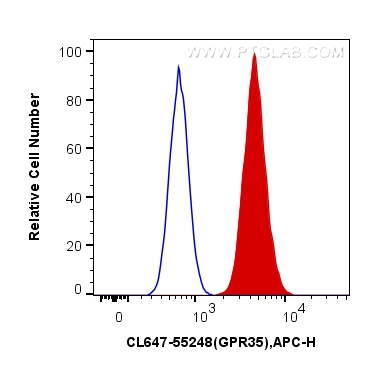验证数据展示
经过测试的应用
| Positive FC (Intra) detected in | A549 cells |
推荐稀释比
| 应用 | 推荐稀释比 |
|---|---|
| Flow Cytometry (FC) (INTRA) | FC (INTRA) : 0.40 ug per 10^6 cells in a 100 µl suspension |
| It is recommended that this reagent should be titrated in each testing system to obtain optimal results. | |
| Sample-dependent, Check data in validation data gallery. | |
产品信息
CL647-55248 targets GPR35 in FC (Intra) applications and shows reactivity with human samples.
| 经测试应用 | FC (Intra) Application Description |
| 经测试反应性 | human |
| 免疫原 | Peptide 种属同源性预测 |
| 宿主/亚型 | Rabbit / IgG |
| 抗体类别 | Polyclonal |
| 产品类型 | Antibody |
| 全称 | G protein-coupled receptor 35 |
| 别名 | Kynurenic acid receptor, KYNA receptor, G-protein coupled receptor 35, G protein coupled receptor 35 |
| 计算分子量 | 34 kDa |
| GenBank蛋白编号 | NM_005301 |
| 基因名称 | GPR35 |
| Gene ID (NCBI) | 2859 |
| RRID | AB_2883650 |
| 偶联类型 | CoraLite® Plus 647 Fluorescent Dye |
| 最大激发/发射波长 | 654 nm / 674 nm |
| 形式 | Liquid |
| 纯化方式 | Antigen affinity purification |
| UNIPROT ID | Q9HC97 |
| 储存缓冲液 | PBS with 50% glycerol, 0.05% Proclin300, 0.5% BSA , pH 7.3 |
| 储存条件 | Store at -20°C. Avoid exposure to light. Stable for one year after shipment. Aliquoting is unnecessary for -20oC storage. |
背景介绍
GPR35, also named as KYNA receptor, belongs to the G-protein coupled receptor 1 family. GPR35 acts as a receptor for kynurenic acid, an intermediate in the tryptophan metabolic pathway. The activity of GPR35 is mediated by G-proteins that elicit calcium mobilization and inositol phosphate production through G(qi/o) proteins (PMID:16754668). This antibody is specific to GPR35.
实验方案
| Product Specific Protocols | |
|---|---|
| FC protocol for CL Plus 647 GPR35 antibody CL647-55248 | Download protocol |
| Standard Protocols | |
|---|---|
| Click here to view our Standard Protocols |
